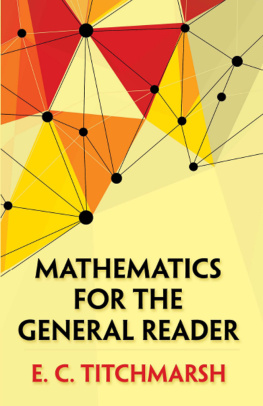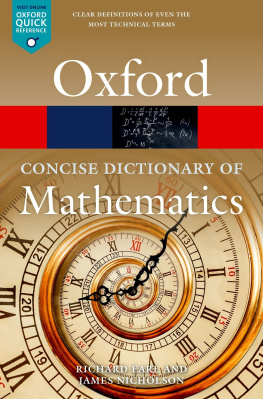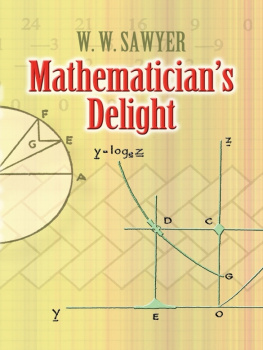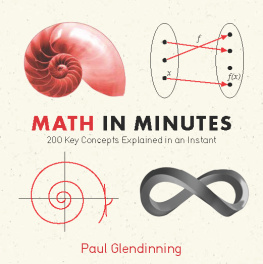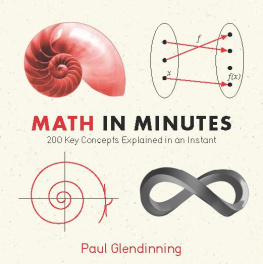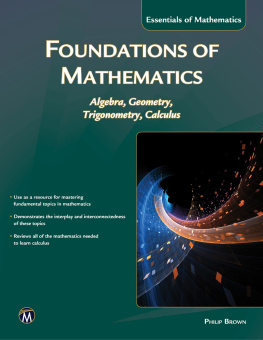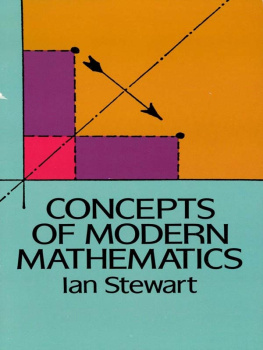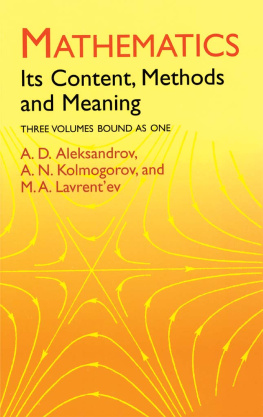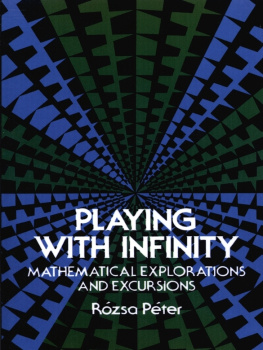MATHEMATICS
for the General Reader
E.C.TITCHMARSH
Dover Publications, Inc.
Mineola, New York
To the three Js
Bibliographical Note
This Dover edition, first published in 2017, is an unabridged republication of the work originally published in 1959 as a Doubleday Anchor Book by Doubleday & Company, Inc., Garden City, New York.
Library of Congress Cataloging-in-Publication Data
Names: Titchmarsh, E. C. (Edward Charles), 18991963.
Title: Mathematics for the general reader / E.C. Titchmarsh.
Description: Dover edition. | Mineola, New York: Dover Publications, Inc., 2017. | Originally published: Garden City, New York: Doubleday & Company, Inc., 1959. | Includes bibliographical references and index.
Identifiers: LCCN 2016043357| ISBN 9780486813929 | ISBN 0486813924
Subjects: LCSH: Mathematics.
Classification: LCC QA37 .T57 2017 | DDC 510dc23 LC record available at https://lccn.loc.gov/2016043357
Manufactured in the United States by LSC Communications
81392401 2017
www.doverpubhcations.com
Contents
Chapter I
COUNTING
Little children easily learn to count. Very early in their lives they notice the existence around them of recognizable objects. As soon as they can speak, they learn to say the names of some of these. Almost at once they notice that some objects may be classed together, as being obviously of the same kind. In particular they notice the existence of pairs of objects, and learn to use the word two. When I speak of two hands and two feet, the child realizes that the set of my hands has something in common with the set of my feet. When I turn on a light and then another light, the child says two lights. This is the beginning of counting.
Soon other numbers, three, four, five and so on are learnt. The use of the word one probably comes later, the existence of single objects being at first too obvious to call for a special name. Nought, the negation of the existence of any objects of a particular class, is a comparatively abstract idea, which only occurs to us when we are used to counting. Some ancient races had no symbol for nought, which they did not think of as the same sort of thing as one or two.
Older children learn the routine of counting up to quite large numbers. Beyond thirty or forty this must soon cease to have any particular meaning for them, but the rhythm of counting (twenty-one, twenty-two, twenty-three) makes it rather like saying very easy poetry. Children sometimes even count backwards to amuse themselves.
It soon becomes obvious that the process of counting can go on a very long way. I once overheard my children discussing the question, What is the largest number? One of them thought that it must consist entirely of 9s. The second thought that it must be possible to get it by using all the words hundred, thousand, million, and whatever else there might be, in the most favourable way (the idea of repetition not being thought of). The third objected that one could never count as far as that, supposing apparently that to make it fair one ought to be able to count through all the numbers up to the largest. They all agreed that the subject presented serious difficulties, and passed on to other topics.
They did not ask me what the largest number was. In this they were undoubtedly wise, because I should not have been able to tell them. I should have been faced, like any other mathematician, with a serious dilemma. Either there is a largest number, and when we get to it we must stop; or we go on for ever, and the set of numbers is endless, or, as we say, infinite.
It might be said that, as all the numbers which are ever actually used or thought of individually form a finite set, we might as well confine our attention to such a set, and avoid the necessity of trying to think about infinite classes of numbers. Perhaps it would be possible to do this, but it would really make the practice of mathematics more difficult. Not only should we be condemned for ever to the trivialities of finite arithmetic, but almost every statement in mathematics would be limited by a condition that the numbers involved must not be too large. Of course in our minds there is no barrier to endless counting. However far we have got, we can always count one more.
Practically all mathematicians agree that there is no upper limit beyond which counting must cease; that is, they agree to regard the numbers which begin with one, two, three, , the primal elements of mathematics, as an infinite class. Such an agreement, or declaration, which is itself incapable of proof, but which is a necessary starting point for further thinking, is called an axiom. The axiom about the set of numbers going on for ever is called the axiom of infinity.
What are numbers?
To children, and probably to most other people, numbers are just the things we count with. They are words such as two or five, which call up in our minds a familiar set of objects, such as the set of my hands, or the set of fingers on one hand. The number spoken relates a named set to one of these familiar sets; that is, it asserts that we could pair off each object of the named set with one of the objects of the familiar set. Two lights might mean that there is a light on my right hand and a light on my left hand. But couples are so often met with that the set of hands may be forgotten, and two just relates a new couple to all those which we have met before.
Generally, if we can pair off the members of one set with the members of another set, so that none of either set is left over, then the two sets must have the same number, whatever that may mean. Number must have a meaning such that it is true that I have the same number of fingers on each hand, and the same number of buttons as buttonholes on my waistcoat (with coats the situation does not seem to be so simple).
The question what numbers are has been much debated by philosophers, and they do not seem to have reached any agreement about it. There is nothing particularly surprising or distressing about this. It has been said that mathematicians are happy only when they agree, and philosophers only when they disagree. Philosophic doubts about the nature of number have never prevented mathematicians from getting on with their calculations, or from agreeing when they have got the right answer. So perhaps the situation is satisfactory to all parties.
One of the most famous attempts to define number was made by Bertrand Russell. I will quote, for example, what he says in his book An Introduction to Mathematical Philosophy. We naturally think that the class of couples is something different from the number 2. But there is no doubt about the class of couples: it is indubitable and not difficult to define, whereas the number 2, in any other sense, is a metaphysical entity about which we can never feel sure that it exists or that we have tracked it down. It is therefore more prudent to content ourselves with the class of couples, which we are sure of, than to hunt for a problematical number 2 which must always remain elusive. Thus the number of a couple will be the class of all couples. In fact, the class of all couples will be the number 2, according to our definition. At the expense of a little oddity, this definition secures definiteness and indubitableness; and it is not difficult to prove that numbers so defined have all the properties that we expect numbers to have.
This plausible-sounding definition of the number 2 actually raises many difficulties. For example, are we really sure what we mean by the class of all couples? Are we to admit physical objects only, or all objects of all thought (in pairs) as members of the class? If, as we must suppose, it is the latter, it seems that I can always add to the class by thinking of a fresh couple, and thus that I can create couples which you know nothing about. It is true that you can always test any couple, the existence of which I announce, to see whether it is one; but that removes the ultimate 2 from the class of couples to some test for couples, which is just what Russell seems to wish to avoid.

